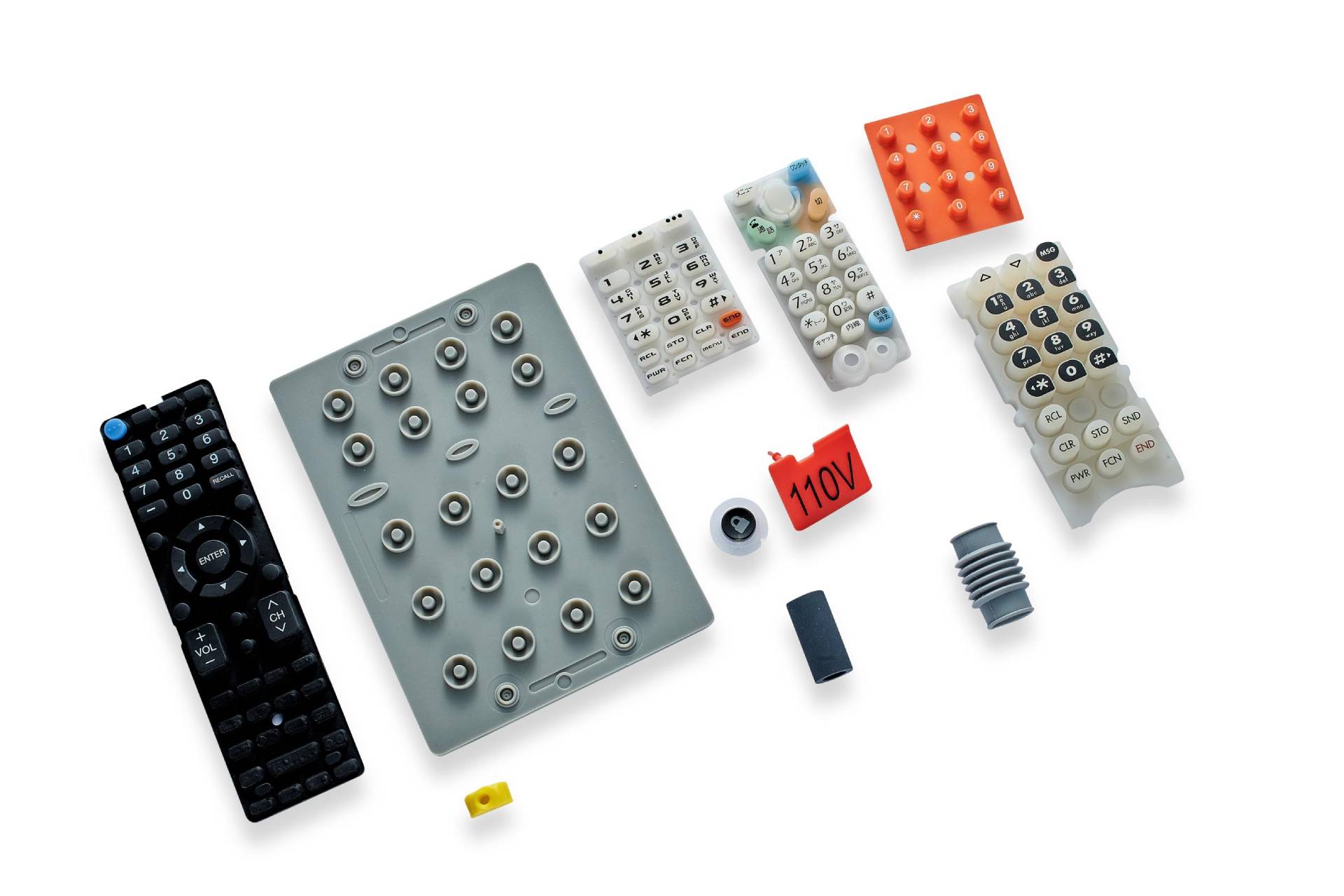Expert recommendations for extending the life cycle of Rubber Keypads
Checking Out the Production Refine Behind Rubber Keypads and Their Value in Modern Tools
Rubber keypads are pivotal in the capability of modern devices. Their production procedure entails careful option of products and accurate methods. Keypads are made to enhance individual communication while making certain longevity and integrity. Recognizing exactly how these parts are made discloses their significance throughout various applications. What elements add to their performance, and how do these aspects affect customer experience? The solutions might improve perceptions of this daily innovation.
Summary of Rubber Keypads and Their Applications

Rubber keypads are versatile components widely made use of in numerous digital tools, ranging from customer electronic devices to commercial tools. Their design enables a responsive response, making them a perfect selection for applications calling for individual interaction. Generally discovered in products such as push-button controls, calculators, and medical tools, rubber keypads assist in convenience of use and access.
In industrial settings, they serve crucial functions in equipment and control panels, where longevity and resistance to environmental aspects are essential. The non-slip surface improves grasp, promoting integrity sought after problems. Additionally, their lightweight nature and personalized shapes make it possible for suppliers to develop customized options that fit certain requirements. With advancements in technology, rubber keypads remain to advance, integrating attributes like backlighting and boosted level of sensitivity. On the whole, their versatility and useful benefits add significantly to the efficiency of numerous gadgets throughout several markets.
Products Made Use Of in Rubber Keypad Production
Keypad producing depends on an option of materials that boost both capability and sturdiness. The main material used in the manufacturing of rubber keypads is silicone rubber, known for its exceptional durability and versatility. This material permits keypads to endure duplicated pushing without shedding form or efficiency. Additionally, thermoplastic elastomers (TPE) are commonly used due to their convenience of molding and ability to supply a soft-touch feel.
Coloring representatives, such as pigments, are integrated to guarantee vibrant, long-lasting tones that boost aesthetic appeal. Additionally, additives like anti-UV agents and flame resistants may be blended into the rubber to boost weather resistance and safety compliance. The selection of products straight influences the keypad's tactile reaction, longevity, and general efficiency in different gadgets. Eventually, the careful selection of these elements is vital for the manufacturing of high-quality rubber keypads that fulfill consumer and industry demands.
The Layout Refine of Rubber Keypads
When creating rubber keypads, the style procedure plays an important role in determining capability and individual experience. Developers begin by defining the keypad's meant use, considering variables such as the device it will accompany and the target customer demographic. This first phase consists of mapping out formats that prioritize ergonomic aspects, guaranteeing the tricks are conveniently available and suitably spaced.
Next off, designers concentrate on the responsive comments preferred from the keypads, which affects the selection of materials and vital shapes. Prototyping is important in this phase, permitting designers to check numerous styles for comfort and responsiveness.

Production Techniques for Rubber Keypads
The manufacturing process for rubber keypads entails a collection of precise methods that guarantee quality and capability. Liquid silicone rubber (LSR) is commonly utilized due to its sturdiness and versatility. The process starts with blending the raw products, including silicone, colorants, and treating agents. This combination is then infused right into mold and mildews designed to shape the keypads properly.
Complying with injection, the shaped keypads undergo curing, a home heating process that solidifies the material (Rubber Keypads). This is commonly executed in a press, making certain the keypads achieve the wanted hardness and strength
High Quality Control Steps in Production
To assure that rubber keypads meet high requirements of quality and capability, strenuous quality control actions are executed throughout the production process. These measures begin with raw material examination, making certain that only the highest-grade elastomers are made use of. Throughout the production phase, drivers carry out routine checks to check parameters such as temperature, pressure, and blending times, crucial for accomplishing regular product quality.
Post-production, each set of keypads undertakes extensive screening, including tactile response assessments and durability tests to review efficiency under various problems. Visual examinations are also carried out to determine any flaws, such as bubbles or disparities in texture. Furthermore, conformity with sector criteria is verified, ensuring that the keypads satisfy safety and performance criteria.
The Duty of Modern Technology in Keypad Development
Modern technology plays a vital function in the growth of rubber keypads by enabling advanced production methods that enhance precision and performance. Furthermore, ingenious material selection enables improved longevity and responsiveness in keypad performance. These developments not only improve manufacturing yet additionally raise the general quality of the end product.
Advanced Manufacturing Techniques
Improvements in production methods revolutionize the manufacturing of rubber keypads, improving both effectiveness and precision. Technologies such as injection molding and 3D printing have changed conventional procedures, making it possible for makers to produce complicated styles with lowered waste and boosted turnaround times. Automation plays a crucial function in this evolution, simplifying production line and lessening human error. Furthermore, computer-aided layout (CAD) software application enables elaborate customization, ensuring that keypads fulfill particular individual requirements. Quality control measures have additionally advanced, incorporating real-time surveillance systems that identify problems early in the production cycle. These innovations not only enhance the longevity and functionality of rubber keypads but likewise support the growing demand for tailored solutions in numerous markets, from customer electronics to vehicle applications.
Cutting-edge Material Option
The evolution of making techniques has led the way for innovative material selection in their explanation rubber keypad growth. Advancements in polymer scientific research have actually introduced products that enhance sturdiness, flexibility, and responsive comments. Manufacturers currently utilize thermoplastic elastomers (TPE) and silicone substances, which offer exceptional resistance to put on and environmental aspects. These materials enable for the development of keypads that can withstand prolonged use while preserving aesthetic appeal. Furthermore, the combination of finishes and ingredients boosts functionality, such as enhancing hold and reducing rubbing. The selection of materials is important, as it straight affects the efficiency and durability of keypads in numerous devices, from consumer electronics to commercial equipment. This innovative strategy continues to form the future of keypad design and use.
The Influence of Rubber Keypads on User Experience
Rubber keypads greatly affect user experience via their improved responsive feedback, which enables even more accurate communication. In addition, their durability and long life add to regular efficiency over time, decreasing the requirement for constant substitutes. This mix of functions makes rubber keypads a favored option in various applications, ultimately influencing individual satisfaction.
Enhanced Tactile Feedback
Enhancing responsive reaction substantially affects customer experience, particularly in tools that depend on keypads for interaction. Rubber keypads give a special mix of soft qualities and strength, allowing customers to feel distinctive feedback with each press. This comments enhances a feeling of control and precision, vital in applications varying from smart devices to industrial equipment. Individuals typically report better complete satisfaction and effectiveness when engaging with tools that include well-designed rubber Discover More keypads, as they facilitate quicker and a lot more exact input. Furthermore, the ergonomic style of these keypads can decrease finger tiredness, advertising longer usage durations without discomfort. Generally, the improved responsive reaction given by rubber keypads substantially adds to a more pleasurable and intuitive user experience in contemporary innovation.
Durability and Long life
A key facet of customer experience with rubber keypads depends on their resilience and durability. These keypads are designed to stand up to substantial usage, resisting damage that often affects other products. The durable nature of rubber warranties that keypads preserve their capability and appearance with time, which is important for devices often used in various environments. Users gain from the dependability of rubber keypads, as they can withstand exposure to dirt, wetness, and temperature changes without degrading. This strength not just enhances user satisfaction yet also minimizes the demand for constant replacements, eventually adding to cost-effectiveness for manufacturers. Essentially, the resilience of rubber keypads substantially affects the total efficiency and user experience in modern-day tools.
Often Asked Inquiries
The Length Of Time Do Rubber Keypads Usually Last in Instruments?
Rubber keypads commonly last in between 5 to ten years, relying on usage, environmental variables, and top quality of products utilized (Rubber Keypads). Normal deterioration can reduce their life expectancy, affecting functionality and user experience gradually
Can Rubber Keypads Be Customized for Details Applications?
Rubber keypads can indeed be customized for specific applications, enabling modifications in size, color, shape, and texture. This versatility makes it possible for producers to produce tailored options that fulfill varied individual demands and boost capability in various gadgets.
Are Rubber Keypads Ecologically Friendly?
Rubber keypads are frequently not taken into consideration eco-friendly as a result of their petroleum-based materials. Developments in sustainable manufacturing methods and the advancement of bio-based alternatives are gradually boosting their eco-friendly effect in different applications.
What Prevail Concerns Dealt With Throughout Rubber Keypad Manufacturing?
Common issues dealt with during rubber keypad production consist of inconsistent material quality, mold and mildew problems, improper healing times, bond failures, and difficulties in achieving exact responsive comments. These troubles can lead to lowered item performance and client frustration.
Just How Do Rubber Keypads Contrast to Various Other Sorts Of Secret Switches?
Rubber keypads supply a softer feel and quieter operation contrasted to mechanical buttons, which provide responsive comments. Nevertheless, rubber keypads might wear faster and lack the accuracy Bonuses that some individuals like in high-performance applications.
The key product utilized in the manufacturing of rubber keypads is silicone rubber, recognized for its superb durability and adaptability. When developing rubber keypads, the style procedure plays a necessary duty in establishing functionality and user experience. Rubber keypads considerably affect customer experience via their enhanced tactile response, which enables for more accurate communication. Individuals commonly report better fulfillment and efficiency when communicating with gadgets that include properly designed rubber keypads, as they assist in quicker and more exact input. A key element of individual experience with rubber keypads exists in their toughness and long life.